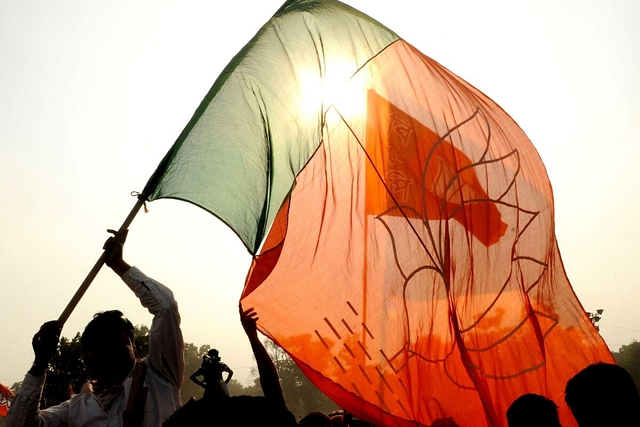Politics
In Maps: How To Look At Odisha For 2024

A BJP supporter with party flag during an election campaign rally. (Samir Jana/Hindustan Times via Getty Images)
Odisha is a quiet state. It goes to the polls without much fuss, and normally returns clear mandates. For the past quarter century, Chief Minister Naveen Patnaik and his Biju Janata Dal (BJD) have maintained an overweening primacy in both provincial and general elections.
But that is slowly changing at last. To fully understand this change, the how and why of it merit analysis as two separate components.
Thus, in the first part of our series on the forthcoming general elections in Odisha, we shall survey the results of the past three elections.
First, the Bharatiya Janata Party (BJP) has almost replaced the Congress as the principal opposition party in the state. As the table above shows, this is a process which began in 2014, and is expected to be largely completed in 2024.
At the same time, the vote share of the ‘Others’, too, is consistently reducing.
Second, bipolarity is increasing steadily in the state, and is expected to approach 90 per cent in 2024.
As a second table below shows, this significant shift has a lot to do with votes shifting away from the Congress more to the BJP in 2014, and then again in 2019 in a bigger way.
Note also how a minor portion of the BJD and ‘Others’ vote shifted to the BJP in 2019.
Third, geographically, and in the first instance, the BJP replaced the Congress as the principal opposition party in the hinterland between 2009 and 2014.
This is what let the BJD sweep the state in 2014. But between 2014 and 2019, the BJP became the dominant party in the hinterland, and established its presence in the urban belt on the coast, winning Bhubaneshwar, losing Puri very narrowly, and coming a firm second in Cuttack.
Our starting point is the BJP vote share in 2009, when it won nil seats. Note how it had already begun to establish itself in the tribal reserved seat of Sundargarh. This was the Sangh at work, at the grassroots.
And this is the win distribution map of the 2009 general elections:
In 2014, the BJP managed to win Sundargarh in a triangular contest, and expanded its vote base down the Mahanadi, into the urban coastal belt. This is the 2014 vote share map:
And this is the 2014 results map:
The BJP’s big surge took place between 2014 and 2019, across the hinterland and forcefully into the coastal plains, mainly at the cost of the Congress.
In 2019, the BJP won 8 seats and came second in 11. The BJD won 12, one of which, Nabarangpur, was a keen three-way contest, and the Congress won one, Koraput, in a low-scoring multi-polar affair.
Six of the BJP’s eight wins were by extremely narrow margins, less than 2 per cent. In contrast, the BJD won by healthy margins in seven seats, it appears that it may hold on to these seats in 2024. The caveat here, of course, is that this assessment is made as things stand, with the campaign yet to begin.
In 2024, the Congress survives in Odisha only in one pocket, and only because of the identity vote. That is set to change. The primary contest, thus, will be between the BJP and the BJD.
The BJP is expected to make some material gains in 2024 in Odisha, not just at the expense of the Congress but also by attracting votes from the BJD's share. The rationale for that will be presented in the succeeding article.
Support Swarajya's 50 Ground Reports Project & Sponsor A Story
Every general election Swarajya does a 50 ground reports project.
Aimed only at serious readers and those who appreciate the nuances of political undercurrents, the project provides a sense of India's electoral landscape. As you know, these reports are produced after considerable investment of travel, time and effort on the ground.
This time too we've kicked off the project in style and have covered over 30 constituencies already. If you're someone who appreciates such work and have enjoyed our coverage please consider sponsoring a ground report for just Rs 2999 to Rs 19,999 - it goes a long way in helping us produce more quality reportage.
You can also back this project by becoming a subscriber for as little as Rs 999 - so do click on this links and choose a plan that suits you and back us.
Click below to contribute.
Latest